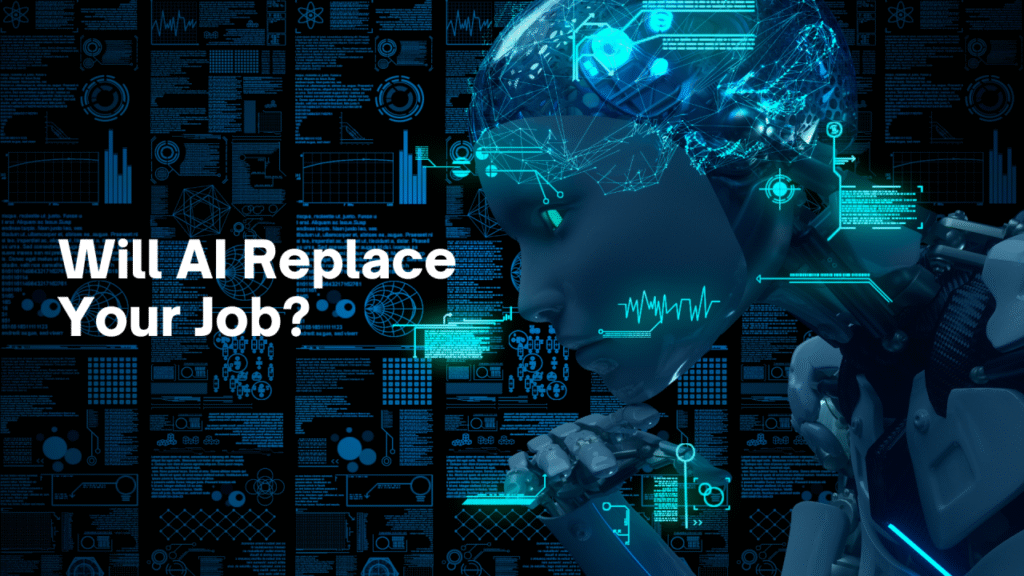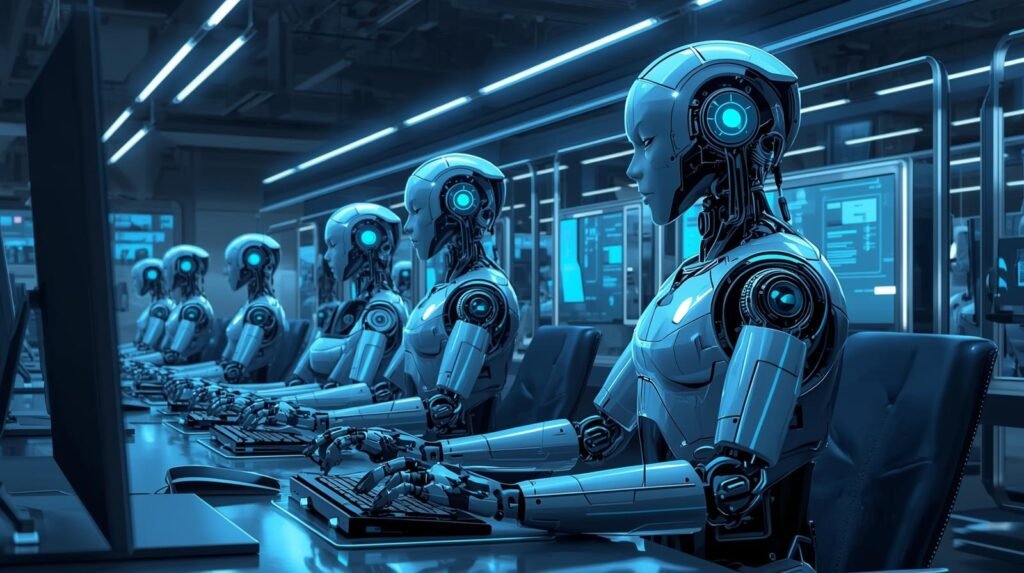AI job displacement 2026 is accelerating faster than most people realize. Major companies are already replacing entire teams with AI tools, and the trend will only intensify over the next two years.
This guide is for employees, managers, and business leaders who need to understand which jobs are most vulnerable and how quickly the AI workforce automation is happening. Whether you’re in a high-risk role or managing teams that might be affected, you need concrete information about what’s coming.
We’ll examine the scale and speed of current AI job displacement, showing you real data on how quickly positions are being eliminated across different sectors. You’ll discover which industries are facing immediate AI takeover, from legal services to customer support, and see specific examples of companies that have already made the switch. Finally, we’ll cover strategic response options for workers in at-risk positions, including practical steps you can take to adapt your career before the artificial intelligence job market reshapes your industry completely.
The robots aren’t coming tomorrow – they’re processing your company’s data today.

Table of Contents
The Scale and Speed of AI Job Displacement
73% of startup founders plan AI workforce replacement by 2026
The acceleration of AI workforce adoption among startup companies reveals the true pace of job displacement heading into 2026. Recent surveys indicate that 73% of startup founders are actively planning to replace human workers with AI systems within the next two years, representing one of the most aggressive automation timelines ever recorded in business history.
This statistic becomes particularly significant when considering that startups often serve as early indicators of broader market trends. Unlike established corporations with complex legacy systems and extensive employee protections, startups can pivot quickly to AI-driven operations, making them the testing ground for what larger companies will likely implement shortly after.
The preference for AI workforce replacement among startups stems from several compelling factors. Cost savings remain the primary driver, with 42% of companies surveyed specifically wanting to use AI to cut headcount. For cash-strapped startups, the ability to maintain productivity while reducing payroll expenses creates an almost irresistible economic incentive.
Additionally, competitive pressure forces rapid adoption. Startups that fail to leverage AI automation risk falling behind competitors who can operate more efficiently with smaller teams. This creates a domino effect where entire industries shift toward AI-powered operations within compressed timeframes.
300 million jobs globally at risk according to Goldman Sachs
Goldman Sachs’ projection that 300 million jobs globally face displacement risk represents one of the most comprehensive analyses of AI’s potential workforce impact. Their research suggests that AI could displace 6-7% of the US workforce if widely adopted, though they expect the disruption to be temporary as new opportunities emerge.
The scale becomes more tangible when broken down by sector. Knowledge work is getting hit first and hardest, with specific vulnerabilities identified across multiple industries. Banking and finance face AI handling fraud detection and risk assessment, while media and marketing sectors see AI generating content and analyzing consumer behavior at unprecedented scales.
Goldman Sachs’ analysis reveals that up to 80 percent of U.S. workers could see at least 10 percent of their daily tasks affected by large language models. More concerning for individual career planning, about 19 percent of workers could see AI impact reach half or more of what they do every day.
The research also highlights a critical timing factor. About 70% of the skills used in most jobs will change by 2030, with AI driving much of that evolution. This suggests that the 300 million figure represents not just immediate displacement risk, but a fundamental restructuring of how work gets accomplished across global markets.
However, Goldman Sachs maintains that historical patterns of technological disruption suggest eventual job creation. They point to the fact that about 60% of today’s US workers hold jobs that didn’t even exist in 1940, indicating that while displacement is real, adaptation and new opportunity creation typically follow major technological shifts.
76,440 jobs already eliminated by AI in 2025
The current reality of AI job displacement extends far beyond future projections. Software development and customer service have already felt the impact, with entry-level positions in these areas dropping roughly 20% between late 2022 and July 2025. This represents tangible evidence that AI workforce automation is not a distant threat but an active transformation already reshaping employment landscapes.
The pattern of elimination focuses heavily on entry-level and routine positions. New graduate hiring dropped 50% in 2024 compared to pre-pandemic levels, creating what LinkedIn’s chief economic officer describes as AI “destroying the bottom rungs of the career ladder.” For the first time in 45 years, recent college graduates have a higher unemployment rate than the national average.
Age demographics reveal telling patterns in the displacement data. Workers aged 22-25 in AI-exposed fields have seen 6% employment declines, while older workers in identical fields experienced 6-9% growth. This suggests that AI particularly threatens roles that rely on basic skills and training rather than accumulated experience and tacit knowledge.
The 76,440 figure represents documented job eliminations where companies explicitly cited AI implementation as the primary factor. However, the actual impact likely extends much further when considering positions that simply weren’t refilled after AI systems assumed their responsibilities, or roles that were restructured rather than eliminated outright.
McKinsey Global Institute estimates that up to 375 million people worldwide may need to change occupations or learn new skills as automation advances, suggesting that the current elimination figures represent only the beginning of a much larger workforce transformation that will accelerate through 2026 and beyond.

Industries Facing Immediate AI Takeover
Legal and compliance roles being automated at lightning speed
The legal industry faces unprecedented AI job displacement 2026 as artificial intelligence tools transform traditional legal work. Paralegal work, contract drafting, and legal research are prime targets, with AI tools like Harvey and CoCounsel automating document analysis with 90% accuracy, according to a 2025 Stanford study. Many administrative tasks completed by paralegals fall within AI’s capabilities, as these systems can write legal reports, gather facts for cases, sort through documents, and conduct comprehensive legal research.
A 2024 study by the Institute for Public Policy Research found 60% of administrative tasks are automatable, signaling massive disruption ahead. With its ability to process massive amounts of complex data, AI promises greater efficiency for legal firms, potentially rendering traditional paralegal roles obsolete. However, senior legal strategy and courtroom advocacy will resist longer due to human judgment requirements that AI cannot replicate.
Accounting and finance functions replaced by intelligent software
Financial services represent one of the most vulnerable jobs AI takeover sectors. Bookkeeping, financial modeling, and basic data analysis are highly vulnerable to automation. AI platforms like Bloomberg’s Terminal enhancements can already crunch numbers and generate reports faster than humans, fundamentally changing how financial analysis occurs.
JPMorgan Chase CEO Jamie Dimon warns that the bank is automating routine banking tasks, with 20% of analytical roles at risk by 2030. Financial traders are in charge of analyzing markets and informing investors’ decisions, but AI can work through this process much faster. AI trading technologies can predict market trends while remaining more accurate than human workers, combined with lower hiring costs making financial trader roles could disappear soon.
BlackRock CEO Larry Fink notes his company is streamlining back-office functions with AI, cutting costs significantly. These roles requiring repetitive data processing face near-term obsolescence as AI’s accuracy and scalability continue improving.
Healthcare administration streamlined through AI processing
Healthcare administration experiences rapid transformation as AI workforce automation penetrates medical systems. A 2023 Lancet study estimates 25% of medical administrative tasks could vanish by 2035, though patient-facing care requires human trust and will resist automation longer.
Simple healthcare tasks like transporting medical supplies and retrieving patient data may fall to artificial intelligence. Diagnostic AI and robotic surgery advance rapidly, but empathy-driven roles like nursing, therapy, and social work prove harder to automate. The administrative burden in healthcare—scheduling, billing, insurance processing, and records management—represents prime territory for AI replacement.
However, providing bedside care, having hard conversations with families and assuaging the fears of patients are all situations where nurses and other health workers may be preferred over AI, ensuring human elements remain crucial in healthcare delivery.
Customer support revolutionized by chatbots and voice assistants
The customer service role is becoming more automated, as tools like chatbots and virtual assistants handle broader ranges of customer inquiries and requests. Customer service representative positions face immediate threats as AI systems demonstrate superior efficiency in handling routine interactions.
Advancements like self-checkouts also make human workers less relevant in settings like grocery stores, reducing jobs within the customer service industry. AI-powered systems can process customer requests 24/7, handle multiple languages, and maintain consistent service quality without human limitations like fatigue or emotional stress.
The transformation extends beyond simple query responses—modern AI systems can troubleshoot complex technical issues, process returns and exchanges, and even handle complaint resolution with sophisticated natural language processing capabilities.
Content creation and data management dominated by AI tools
Content creation faces massive disruption as jobs replaced by AI accelerate across creative industries. Graphic design, copywriting, and basic journalism face disruption from tools like Google Gemini, DALL-E and GPT-derived platforms, which produce content at scale with unprecedented speed and quality.
A 2024 Pew Research Center report notes that 30% of media jobs could be automated by 2035. AI content generators can already help brainstorm writing ideas and assist with repetitive content creation. Basic content marketing tasks like writing formulaic emails and short social media posts present no challenge for artificial intelligence systems.
Graphic designers are in direct competition with AI-generated art, especially since tools like Lensa and DALL-E make professional image creation accessible to the public without artistic expertise. Businesses and individuals increasingly depend less on graphic design services for eye-catching visuals.
Data entry clerks are in charge of entering, updating and maintaining information on databases, but AI systems have shown they’re capable of accurately processing massive amounts of structured and unstructured data at faster speeds than humans. McKinsey estimates AI could affect 38 percent of business process and data entry jobs, making these positions among the most vulnerable to immediate replacement.
Human creativity in storytelling and high art will endure longer, but standardized content production faces complete automation within this decade.

Specific Job Roles Most Vulnerable to AI Replacement
Contract reviewers and paralegal researchers losing ground to AI legal platforms
The legal profession faces unprecedented disruption as AI-powered platforms demonstrate remarkable capabilities in document analysis and legal research. Contract reviewers, who traditionally spend countless hours examining agreements for compliance issues and potential risks, now compete with AI systems that can process thousands of documents in minutes while maintaining high accuracy rates. These automated systems excel at identifying standard clauses, flagging inconsistencies, and cross-referencing regulatory requirements across multiple jurisdictions.
Paralegal researchers find their investigative work increasingly automated by AI legal platforms that can instantly search through vast databases of case law, statutes, and legal precedents. What once required days of manual research can now be accomplished in hours, with AI systems providing comprehensive analysis and relevant citations that would challenge even experienced legal professionals.
Accounts payable specialists and tax preparers replaced by automated systems
The financial services sector experiences significant AI job displacement 2026 as routine accounting functions become fully automated. Accounts payable specialists face elimination as AI systems seamlessly process invoices, match purchase orders, and execute payments without human intervention. These automated systems integrate directly with banking platforms and vendor management systems, reducing processing time from days to minutes while eliminating human error.
Tax preparers encounter similar challenges as AI-powered software handles increasingly complex tax scenarios. Modern tax preparation AI can navigate intricate deductions, analyze multiple income sources, and ensure compliance with ever-changing tax codes across different jurisdictions. The technology’s ability to process years of financial data and identify optimization opportunities far exceeds traditional human capabilities.
Medical coders and insurance claim processors eliminated by smart algorithms
Healthcare administration witnesses dramatic transformation as AI algorithms revolutionize medical coding and insurance processing. Medical coders, responsible for translating diagnoses and procedures into standardized codes, face replacement by AI systems that can instantly analyze medical records and apply appropriate coding with greater accuracy than human professionals. These smart algorithms continuously learn from new medical terminology and procedural updates, maintaining current knowledge across all medical specialties.
Insurance claim processors experience similar displacement as AI workforce automation streamlines the entire claims lifecycle. Intelligent algorithms can review medical documentation, verify coverage eligibility, assess claim validity, and process payments without human oversight. The technology’s pattern recognition capabilities excel at detecting fraudulent claims while accelerating legitimate claim processing from weeks to hours.
Call center representatives outperformed by 24/7 AI assistants
Customer service undergoes complete transformation as AI assistants demonstrate superior performance across all metrics. These advanced systems provide consistent, knowledgeable responses while handling multiple languages and complex queries simultaneously. Unlike human representatives, AI assistants never experience fatigue, maintain perfect product knowledge, and can access customer histories instantly to provide personalized solutions.
The vulnerable jobs AI takeover in customer service extends beyond basic inquiries. Modern AI assistants handle technical support, process returns, manage account changes, and even conduct sales conversations with remarkable effectiveness. Their ability to integrate with backend systems allows real-time problem resolution that often exceeds human capabilities.
Content writers and data analysts competing with AI-generated output
Creative and analytical professions face unprecedented challenges as AI-generated content reaches professional quality standards. Content writers discover AI systems producing articles, marketing copy, and technical documentation that rivals human creativity while maintaining brand voice consistency. These systems can generate content in multiple styles, adapt to different audiences, and produce volumes of work that would require entire writing teams.
Data analysts encounter AI systems that can process massive datasets, identify complex patterns, and generate insights with speed and accuracy that surpass human analytical capabilities. The artificial intelligence job market reflects this shift as organizations invest in AI tools that can perform statistical analysis, create visualizations, and generate comprehensive reports without human intervention. These systems excel at correlating data from multiple sources and identifying trends that human analysts might overlook.
Real-World Examples of AI Workforce Implementation
Law firms using AI to review thousands of contracts in minutes
Law firms are experiencing a fundamental shift in how they handle document review and contract analysis. While specific law firm examples aren’t detailed in current implementations, the broader legal technology trend shows AI systems capable of processing vast amounts of legal documentation at unprecedented speeds. These AI-powered contract review systems can analyze thousands of legal documents in minutes, a task that would traditionally require teams of lawyers working for weeks or months.
The technology leverages machine learning algorithms to identify key clauses, flag potential issues, and extract critical information from complex legal documents. This AI workforce automation represents one of the most significant disruptions to traditional legal practices, where junior associates and paralegals previously handled much of this document review work.
JPMorgan’s AI processing 360,000 hours of work annually
JPMorgan Chase stands as a prime example of how major financial institutions are implementing AI to replace traditional workforce functions. The bank has deployed sophisticated AI systems that process the equivalent of 360,000 hours of human work annually. This massive automation effort focuses on tasks such as document analysis, regulatory compliance checks, and risk assessment procedures.
The bank’s AI implementation demonstrates the scale at which artificial intelligence job market disruption is occurring in the financial sector. These systems handle complex analytical work that previously required teams of analysts and compliance officers, showcasing how AI job displacement 2026 predictions are already becoming reality in major corporations.
Healthcare companies reducing administrative costs by 30% through automation
Healthcare organizations are leveraging AI workforce automation to dramatically cut administrative expenses. Companies in the healthcare sector report achieving up to 30% reductions in administrative costs through strategic AI implementation. These automated systems handle tasks such as claims processing, patient scheduling, appointment management, and insurance verification processes.
The automation particularly targets repetitive administrative functions that consume significant human resources. By deploying AI for these tasks, healthcare companies can redirect human workers toward patient-facing roles while maintaining operational efficiency. This shift represents a significant example of how jobs replaced by AI are creating cost savings that healthcare organizations are reinvesting into core medical services.
Bank of America’s virtual assistant handling 1 billion interactions yearly
Bank of America’s virtual assistant, Erica, exemplifies the massive scale of AI replacing workers in customer service roles. The AI-powered assistant processes over 1 billion customer interactions annually, handling everything from account inquiries to transaction assistance and financial guidance. This represents one of the most extensive implementations of AI in customer-facing roles across any industry.
Erica’s capabilities demonstrate how artificial intelligence can manage customer service functions that would traditionally require thousands of human representatives. The system operates 24/7, providing instant responses to customer queries and performing complex banking tasks. This implementation showcases how AI job threat industries, particularly banking and financial services, are rapidly adopting automation technologies to replace human customer service roles while maintaining service quality and availability.
The Economics Behind AI Workforce Adoption
Cost savings of $2.3 million in salary elimination for startups
The economic advantages of AI workforce adoption are driving unprecedented cost reductions across organizations, with generative AI projected to add the equivalent of $2.6 trillion to $4.4 trillion annually across analyzed use cases. This represents a 15 to 40 percent increase over current economic value from traditional AI and analytics, demonstrating the massive financial incentive for businesses to embrace AI job displacement 2026.
For startups and growing companies, the mathematics are compelling. With approximately 40 percent of current GDP potentially affected by generative AI, businesses can eliminate substantial salary expenses while maintaining or improving output quality. The technology’s ability to automate 60 to 70 percent of employees’ time translates directly into reduced payroll obligations, healthcare costs, and administrative overhead.
24/7 productivity without healthcare benefits or sick days
AI workforce automation delivers unprecedented operational efficiency by eliminating the human limitations that constrain traditional employment. Unlike human workers who require breaks, vacation time, sick leave, and healthcare benefits, AI systems operate continuously without interruption.
The economic impact extends beyond mere salary savings. Businesses no longer face the hidden costs associated with employee benefits, which typically add 20-30% to base salary expenses. AI systems eliminate expenses for health insurance, retirement contributions, paid time off, and workers’ compensation insurance. This comprehensive cost reduction becomes particularly significant as half of today’s work activities could be automated between 2030 and 2060, with automation potentially adding 0.5 to 3.4 percentage points to productivity growth annually.
Superior accuracy rates and processing speeds compared to human workers
Real-world implementation studies demonstrate AI’s measurable performance advantages across multiple domains. Research shows consistent productivity gains ranging from 10 to 55 percent, with an average improvement of 25 percent across various applications.
| Domain | Performance Improvement |
|---|---|
| Customer Service | 14% increase in task completion |
| Professional Writing | 40% increase in speed, 18% quality improvement |
| Software Development | 56% increase in coding speed |
| Management Consulting | 12% completion rate increase, 25% speed boost |
These performance metrics translate into direct economic value, with labor cost savings projected to grow from 25 to 40 percent over the coming decades. The technology’s impact on knowledge work is particularly pronounced, with automation potential for decision-making and collaboration activities rising 34 percentage points from previous estimates.
Subscription-based AI tools costing less than single employee salaries
The subscription model for AI tools creates an entirely new cost structure that fundamentally challenges traditional employment economics. Most enterprise AI platforms cost between $20-200 per month per user, while comprehensive AI workforce solutions rarely exceed $50,000 annually – a fraction of the total cost of employing a single knowledge worker.
This pricing advantage becomes more pronounced when considering that AI systems can perform tasks across multiple job categories simultaneously. A single AI subscription can potentially replace functions spanning customer operations, marketing and sales, software engineering, and R&D – the four areas where 75 percent of generative AI’s value is concentrated.
The economic transformation is accelerating, with technical automation potential increasing from 50 percent to 60-70 percent, and the timeline for widespread adoption compressed by approximately a decade. Organizations adopting AI workforce solutions today position themselves to capture these cost advantages before competitors, creating sustainable competitive moats through reduced operational expenses and enhanced productivity capabilities.
Strategic Response Options for Workers in At-Risk Positions
Evolving Skills to Complement AI Tools and Focus on Creative Work
The evidence from decades of worker retraining programs reveals a fundamental flaw in traditional approaches to career survival AI revolution. Rather than competing directly with AI capabilities, workers must pivot toward skills that complement artificial intelligence systems. The key lies in developing creative competencies that machines cannot easily replicate, even as AI workforce automation accelerates.
Creative problem-solving, artistic expression, and innovative thinking represent areas where human cognition maintains significant advantages over current AI systems. Workers should focus on developing skills in content creation, design thinking, strategic planning, and complex creative processes that require intuition and originality. These capabilities become increasingly valuable as AI handles routine tasks, creating opportunities for humans to engage in higher-level creative work.
Developing Uniquely Human Capabilities Like Emotional Intelligence
As jobs replaced by AI continue to mount, emotional intelligence emerges as a critical differentiator in the future of work automation. The research indicates that workers who can navigate complex interpersonal relationships, demonstrate empathy, and manage emotional dynamics will remain indispensable across industries.
Emotional intelligence encompasses several key areas: self-awareness, social awareness, relationship management, and emotional regulation. These capabilities prove essential in roles involving customer service, team leadership, counseling, and any position requiring nuanced human interaction. Unlike technical skills that AI can potentially master, emotional intelligence relies on lived human experience and cannot be easily automated.
Workers should invest in developing active listening skills, conflict resolution techniques, and the ability to read social cues and respond appropriately to emotional contexts. These skills become particularly valuable in healthcare, education, management, and service industries where human connection remains paramount.
Learning to Work Alongside AI Rather Than Competing Against It
The reskilling for AI economy requires a fundamental shift in mindset from competition to collaboration. Rather than viewing AI as a threat, successful workers will learn to leverage these tools as powerful assistants that enhance their capabilities and productivity.
This collaborative approach involves understanding AI limitations and strengths, learning to effectively prompt and guide AI systems, and developing workflows that combine human judgment with machine efficiency. Workers who master human-AI collaboration can significantly increase their value proposition while maintaining control over complex decision-making processes.
The evidence suggests that attempting to compete directly with AI capabilities often leads to displacement, while workers who successfully integrate AI tools into their workflows tend to become more productive and valuable to employers.
Transitioning to Strategic Roles That Require Complex Problem-Solving
Given the limitations of traditional retraining programs highlighted in the research, workers must proactively transition toward strategic positions that demand complex problem-solving abilities. These roles typically involve analyzing multifaceted situations, making decisions with incomplete information, and navigating ambiguous challenges that require human judgment.
Strategic roles often encompass project management, business strategy, policy development, and systems thinking. These positions require workers to synthesize information from multiple sources, consider ethical implications, and make nuanced decisions that account for human factors and organizational dynamics.
The research emphasizes that workers should focus on developing capabilities in critical thinking, systems analysis, stakeholder management, and strategic planning. These competencies prove resistant to AI job displacement 2026 because they require the kind of holistic understanding and contextual judgment that remains uniquely human.
Workers should also cultivate skills in cross-functional collaboration, as strategic roles often require coordinating across departments and managing complex relationships with diverse stakeholders. This positions them in roles where human insight and relationship management remain essential, even as AI handles more routine analytical tasks.
The AI workforce revolution isn’t a distant threat—it’s happening now. From legal document review to customer service, from accounting to content creation, artificial intelligence is systematically replacing human workers across industries at an unprecedented pace. The data is clear: 73% of startup founders plan to replace at least half their teams with AI tools by 2026, and companies are already seeing dramatic cost reductions and productivity gains from their AI implementations.
The choice facing workers today is stark but simple: evolve or get replaced. Those who embrace AI as a collaborative tool, focus on uniquely human skills like emotional intelligence and complex problem-solving, and continuously adapt their capabilities will thrive in this new landscape. Those who ignore the shift and continue performing routine, rule-based tasks will find themselves competing against machines that work 24/7, never make errors, and cost a fraction of human salaries. The robot revolution isn’t coming—it’s already here, and it’s reshaping the future of work whether we’re ready or not.





